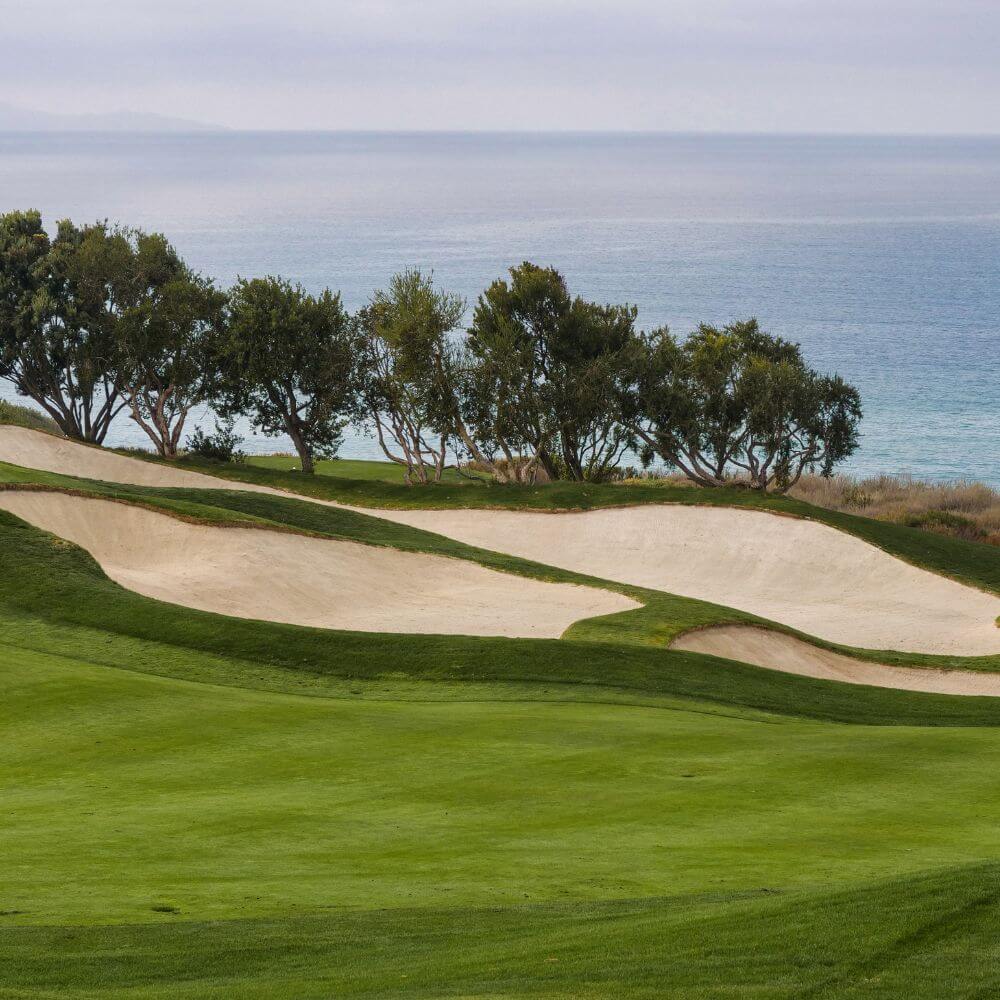It's the bane of every golfer's existence: the dreaded bunker. You know the one, that deep, dark hole filled with sand just waiting to swallow up your golf ball. But what exactly is a bunker, and why does it seem to be so intimidating? We're here to answer all your questions about bunkers so you can approach them with confidence (and maybe even enjoy them!).

What Is a Bunker?
A golf bunker is a unique hazard that provides an exciting challenge for any golfer. It consists of a hollowed-out area or technically a specially prepared area, filled with sand to test the player's ability to hit their ball out from the sand. It is also called a sand trap.
According to the USGA Rules of Golf, the bunker is one of 5 defined areas of the golf course. Here are the five distinct areas:
- The General Area
- The Tee Box
- Any Penalty Area
- Bunkers
- The Putting Green
Types of Bunkers
A golf bunker typically refers to an area of the course filled with sand. They can be located in the fairway, bordering the fairway, or around the green. The purpose of a bunker is to protect the hole and provide an additional challenge to golfers. Bunkers come in all shapes and sizes, ranging from small depressions in the ground filled with sand to large areas with dramatic contours. The exact shape and size of bunkers vary from course to course. Let's take a look at the different types.
- Fairway Bunker - these bunkers are strategically located adjacent or parallel to the fairway. They can be on the right or left side of the fairway and are designed to catch errant tee shots that miss the fairway.
- Cross Bunker - this is a wide or expansive bunker that cuts across (perpendicular) the fairway rather than running alongside it. The placement of this type of bunker forces you to hit over it in order to advance your ball further up the fairway or onto the green.
- Greenside Bunker - these are bunkers placed alongside the green. They are intended to protect the green and catch shorts hit too long or short of the green as well as shots that fade or draw too much and miss the green right or left.
- Pot Bunker - these can be the most penal of bunkers and are often found on links-style golf courses. They are typically small, round, and usually very deep. The faces can be so steep that in order to get out of them you are forced to hit sideways or even behind you.
- Waste Bunkers - according to the USGA these are not hazards and thus are not considered bunkers or sand traps. Although they can be large sandy areas, desert, or natural areas that border the golf course they are not within a specially prepared area that would define a bunker. They are in the general area.
- Grass Bunkers - these are also not hazards and are not considered sand traps. These are holed-out areas that at one time may have been filled with sand and designed as a bunker but now are grown over with grass. Playing out of these is like playing out of the rough.
Understanding Bunker Rules
When playing golf, it's important that you understand how bunkers work and what kind of rules apply when your ball enters one. According to USGA guidelines, your ball is in the bunker when it touches any part of the sand. When you are in the sand you are not allowed to take practice swings touching the sand. You can not touch the sand around your golf ball. You can not test the condition or consistency of the sand. And finally, you can not ground your golf club in the sand prior to taking your swing.
You can remove natural objects like sticks and leaves from the bunker as well as artificial objects as these are not intended to be part of the obstacle of playing from the sand.
If you have an unplayable lie in the sand or you just don't like your lie in the sand, you have four options. You can take an unplayable lie with a penalty of stroke and distance. This would entitle you to take lateral relief within two club lengths or take on-the-line relief back in the bunker. Both of these options require you to drop the ball in the bunker. You can also return to the spot of the stroke that put you in the bunker. And more recently there is now a 4th option. You can take relief outside the bunker on-line and as far back as you want to go. However, this will cost you 2 penalty strokes.
A Very Brief History of Why it's Called A Bunker?
Golf has a lot of history. And a lot of that history comes from Scotland. Back in those early days sand was scattered across the course and small creeks ran to the ocean. Over time, these elements were transformed into obstacles we recognize today-- this is how bunkers came to be. Filling holes with sand in strategic places - this is what the bunker is all about. It seems to be unique to Scotland and the game of golf.
The term bunker is also linked to the quarry pits that you find on classic old courses like Aberdeen and Gullane. It wasn't until 1812 that the term 'Bunker' became part of the golfing language and included in Royal & Ancient Rules.
So there you have it, a brief history of the humble bunker. From its early days as sand scattered across golf courses to its current status in modern-day rules, bunkers are here to stay. Whether they’re protecting greens from overly aggressive shots or providing an interesting challenge for experienced players, bunkers add another layer of complexity and beauty to the game we all love.
Don’t forget that when you're facing your next shot—or even just admiring one on television—that these traps were born out of a centuries-old tradition! Now grab your clubs and get ready for some fun in the sand.










Member discussion